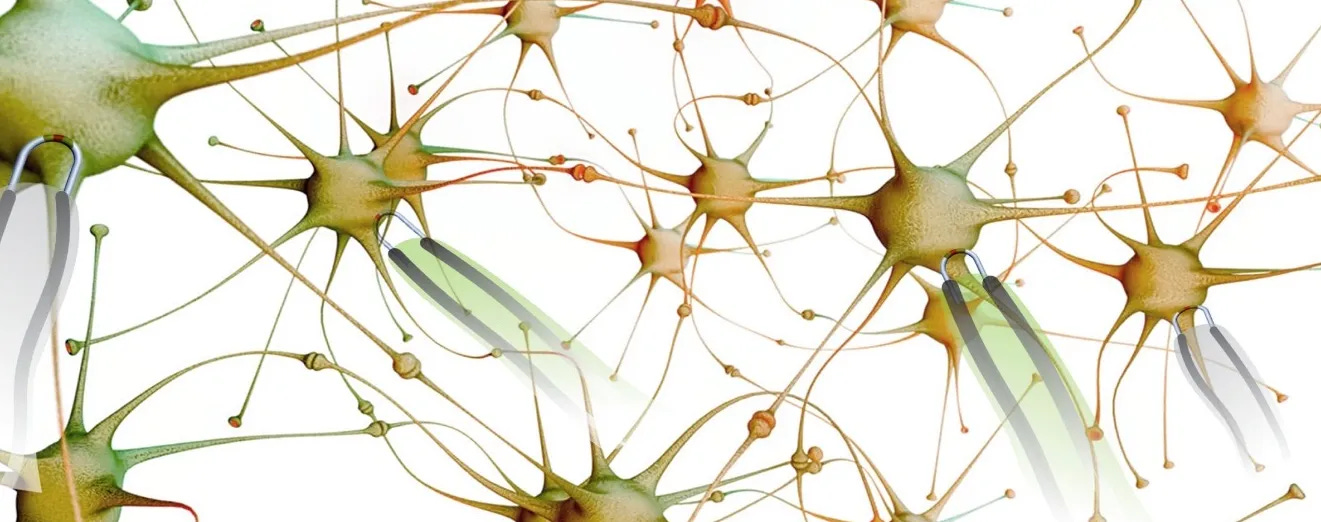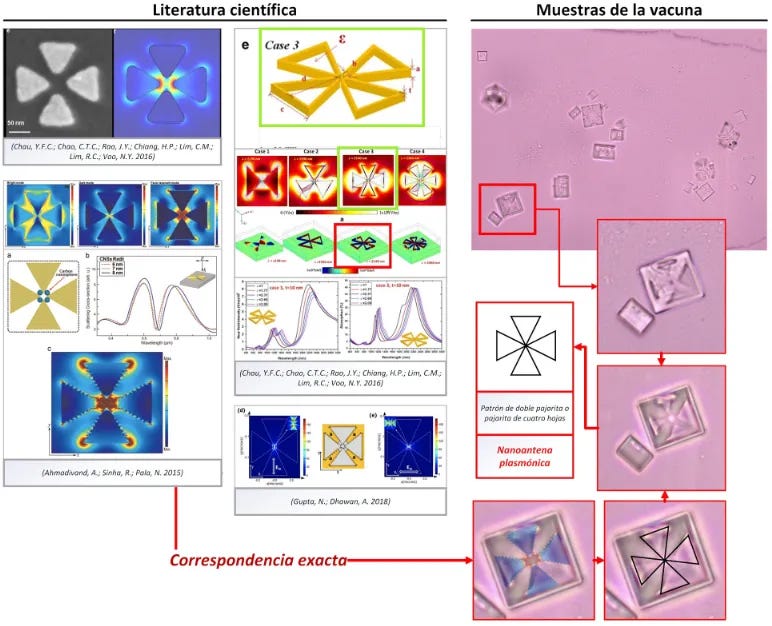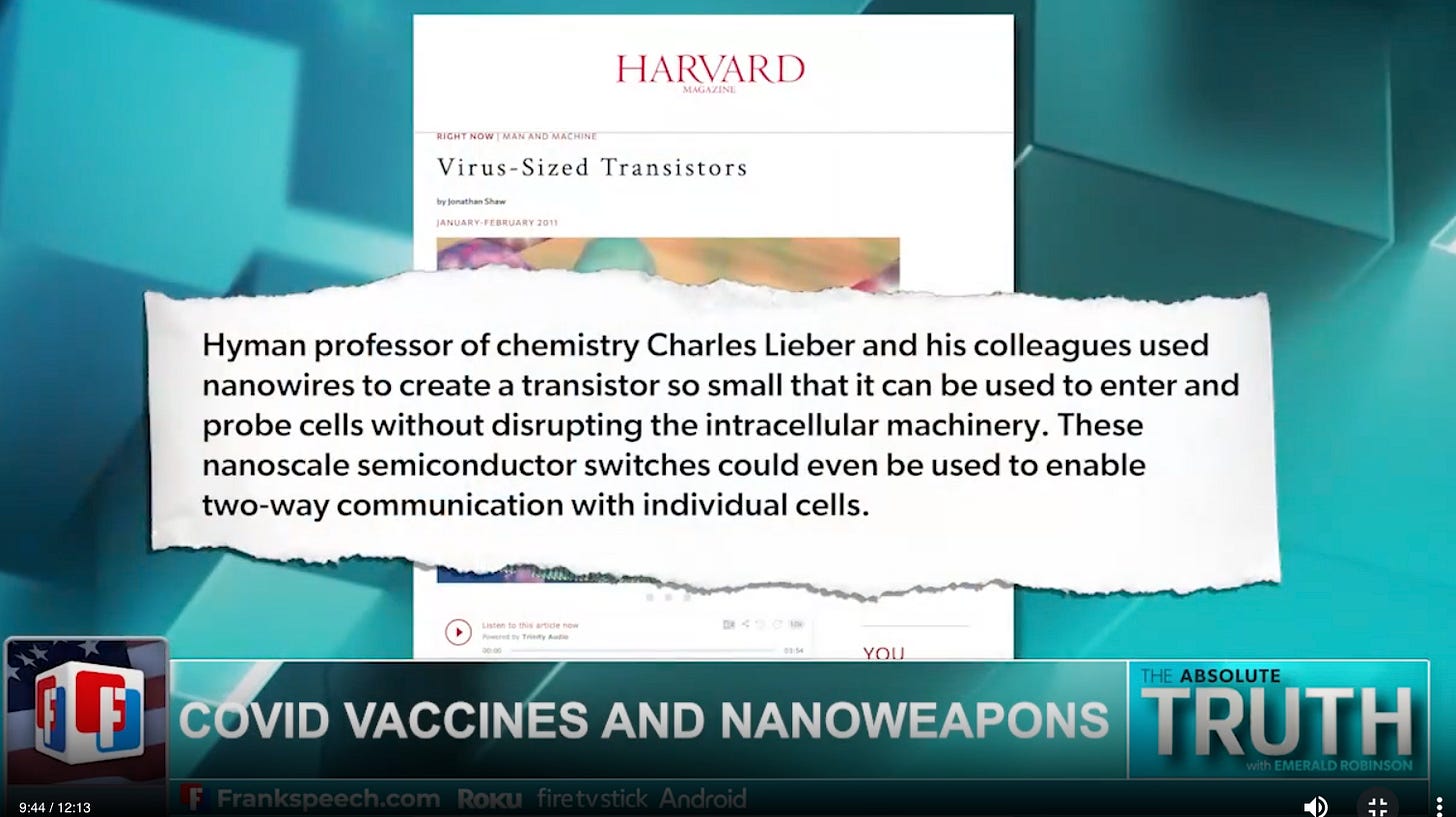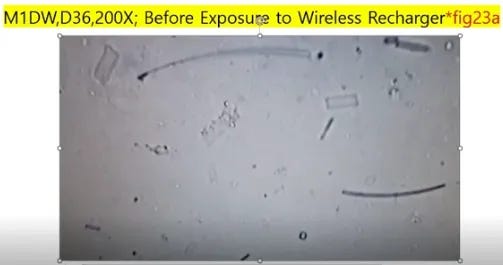A Whole Lot Was Going on with Dr. Charles Lieber
A neuroscientist known for using “nanowires to connect brain cells" was arrested for selling technology to the CCP in 2020, highlighting the importance of nanotech in agendas for global influence

Dr. Charles M. Lieber, Chairman of Chemical Biology at Harvard and a top nanotech scientist, was arrested in 2020 for failing to report his intellectual property dealings in China. He had signed a lucrative contract with a Chinese university in WuHan to set up a “shadow lab” to duplicate his research and bring his expertise in nanotechnology over there. At the time, he was also working at Harvard and receiving multiple research grants from the US Department of Defense and NIH, which required him to disclose foreign conflicts of interest. I had seen the news story in 2020, but did not realize the stunning implications at the time because the mainstream media of course does not tell you what the applications of “nanoscience” actually are. I recently came across his name again on social media and it struck me as very revealing of the times we live in. Not only was Dr. Lieber a highly sought-after nanotechnology expert in brain-computer interface applications, but he was arrested right after the outbreak of COVID for failing to report his technology transfer dealings in WuHan. Most definitely nothing to see there.
This story simultaneously exposes several important issues about our world today that many people may otherwise have a hard time wrapping their mind around:
Dr. Charles Lieber was a top nanotechnology scientist so well-known for his work in neuroscience applications that he was also recruited to work on projects like Neuralink. Nanotechnology, sometimes known as smart dust, is fine enough to be absorbed through the skin like a gas and permeate the blood-brain barrier. One of the foremost applications of nanotechnology is in enabling AI to directly access the human brain in ever more precise ways.
China has its own a fully-fledged neurological targeting program, “NeuroStrike,” which has been reported in mainstream media outlets such as Fox News, the Independent, Washington Post, the New York Post, Times of India, and many others.
Defense papers openly state that the same nanotechnology that Dr. Lieber was working on targets civilians populations in order to influence public opinion. The literature admits that civilians are a primary target of neuroweapon arsenals, and that the primary objective of these hybrid warfare operations is to affect public opinion and engineer certain outcomes in society.
This article is not meant to be too technical as I don’t have a science background (other than as a blog writer in tech), and nanowire neural networks is a very advanced subject to say the least. But my point here is that a person like myself is able to figure out that nanotechnology for the brain-computer interface is very real, that evidence of artificial nanoparticulate structures which has yet to be refuted on a scientific basis can be found almost ubiquitously, and that open source defense writing on this subject leaves no mystery as to whether civilians are intended targets of neuroweapon technologies. That being said, the sources I reference below are going to get into the nitty-gritty of nanotechnology for the brain-computer interface.
Nanowire Networks for Read and Write Brain Interfaces
A Harvard Magazine article “Virus-Sized Transistors” says the following about Dr. Lieber’s work:
“Hyman professor of chemistry Charles Lieber and his colleagues used nanowires to create a transistor so small that it can be used to enter and probe cells without disrupting the intracellular machinery. These nanoscale semiconductor switches could even be used to enable two-way communication with individual cells.”
Dr. Lieber was working on what defense and medical research papers euphemistically refer to as “directly interfacing with neurons” and “modulating neuronal activity”. What this really means is that nanotechnology is used for mind control. I was hoping I would come across a defense or medical paper that uses this language when I found that the Wikipedia page on Dr. Charles Lieber literally says he was known for his nanoscience contributions in “modulation of neuronal activity in brain science.” Wikipedia cites one research paper he co-authored that talks about using “nanowires to connect brain cells” (and create artificial intelligence neural networks parallel to the natural functions of the brain). Another paper he co-authored explains how 3D modulation of brain activity enables interfacing with complex neural networks—using a model overview of the brain to then strategically engage neural networks in various specific parts of the brain. According to Wikipedia, some of Dr. Lieber’s other accomplishments in nanotechnology for brain science include designing technology that mimics the structure of natural tissue, aiding the integration of electronics into the central nervous system in a minimal or “non-invasive” manner, and designing injectable nanorobotics (“noninvasive integration of the injectable electronics with neuronal circuitry”).
Further investigation into Dr. Lieber’s scientific literature on nanowire networks confirms that he was working on technology that creates a self-assembled neural network parallel to the functioning of the brain, which is capable of controlling the firing of (or suppression of) neurons when triggered by frequency. Dr. Charles Lieber co-authored an article titled, Nanowire probes could drive high-resolution brain-machine interfaces, which says the following:
“A central challenge in the field of electrophysiology is to achieve intracellular recording of the complex networks of electrogenic cells in tissues. […] Recent advances in nanowire-based bioelectronics have demonstrated minimally-invasive intracellular interfaces and highly-scalable parallel recording at the network level. Combined with in vivo recording platforms, these advances can enable investigations of dynamics in the brain and drive the development of new brain-machine interfaces with unprecedented resolution and precision.”
One of the other co-authors of the article, Anqi Zhang, was a student under supervision of Dr. Lieber who specialized in the neurophysiology applications of flexible nano-/micro-bioelectronic mechanisms. A key ingredient to enabling nanowire networks to directly interface with neurons is hydrogel, which, because of its characteristics that mimic organic tissue, enable nanoparticles to wrap around neurons. According to this research paper on tissue-engineered nerve interfaces, “biomimetic hydrogels used in tissue engineering […] enable targeted cellular behavior.” Here’s more from other scientific literature on hydrogel-enabled brain-computer interfaces:
“Biomimetic hydrogels used in tissue engineering can improve tissue regeneration and enable targeted cellular behavior; there is growing interest in combining hydrogels with microelectronics to create new neural interface platforms to help patient populations. […]
The assembly process that was developed resulted in repeatable and consistent integration of microelectrode arrays within a soft tissue-engineered hydrogel. As reported elsewhere, these devices have been successfully implanted in a rat sciatic nerve model and yielded neural recordings.”
Though the frequencies we bathe in every day already make it possible for supercomputers to directly access the brain, it seems there are advantages to having a resident physical nanotechnology network in place. For example, this research paper on nanowire networks states, “The ability to exploit both encoding and consolidation of information on the same physical substrate would open radically new perspectives for in materia computing.” Another paper on nanowire networks also suggests, “[a] physical neural-like network [… is] fundamentally different from data-driven statistical machine learning using artificial neural network algorithms.”
I found many of the above research papers in an article by Dr. Ana Mihalcea, which notes the following:
“The rewiring of the brain connectome has been long known. Our brains have neuroplastic abilities, meaning our brain changes as new concepts are being incorporated into the wiring. Now imagine that the rewiring of the brain connectome is done artificially, without a persons knowing, via nanowires and hydrogels. One would not know that a parallel processing platform is being installed in the brain, but people who did not get this processing platform injected into them would notice that a person is changing in personality, can no longer process certain information, seems to be blocked from understanding logical processing of self evident information.”
- Dr. Ana Mihaclea
I found the above quote particularly salient as, in personal life, I’ve observed that it is increasingly difficult to get simple facts across to people. People have always been more emotionally- and socially-minded than attentive to evidence and facts. But I have encountered many instances in which no amount of fact seems to make any difference, especially when emotionally-charged disagreements are involved. These symptoms are eerily similar to the applications of nanotechnology discussed in a NATO Magazine article that we’ll get into later in this article.
It’s important to remember that the type of technology Dr. Lieber was working on creates a parallel processing platform within the brain that people might not necessarily notice, though it is affecting their thought processes and perceptions. Scientific literature describes how the brain’s natural functions are mimicked in the designs of these Artificial Intelligence neural networks, which could indicate that their performance within the brain is very camouflaged, masquerading as normal brain functions. Worryingly, spokesmen (or what is akin to spokesmen) for DARPA and the DoD like Georgetown University professor Dr. James Giordano very openly state that neurotechnologies such as those described above both already exist and are currently operational. Dr. Giodano’s very frank lectures are available for anyone to see on YouTube (see the above link for a few quick highlights of very startling statements he regularly makes). In this short video, Dr. Giordano talks about how far along nanotechnology for the brain-computer interface already is:
“It’s not just a question of using [neurotechnologies] to depict what’s going on in the brain […] but if I can drift into what appears to be bellicose or military technology, to target those things—targets. […] Developing improved means of much more stereospecific approaches to accessing the brain. Not crudely, but ever more creatively. Not just highly invasively, but increasingly non-invasively. Utilizing other forms of technology and engineering such as nanoparticulate matter that we can then create into sensors and transmitters—that can be inhaled, ingested, rubbed on, that can then be migrated into the brain to form vast arrays of sensors and transmitters, to be able to read information from the living brain and write information into the living brain in real time, remotely. This is a current project of the Defense Advanced Research Projects Agency here in the United States called N3 (Next Generation Non-Invasive Neuro-Modulation) […]”
“Because if in fact that same technology that allows us to literally read the mind by scanning and interpreting the data we get from the structures and functions of the brain, and the inverse of that is that we can actually write into the living brain—that’s mind control.”
In other words, Dr. Lieber was working on mind control technology that is so “non-invasive” that it is impossible to detect, as nanoparticles are so fine that they can be absorbed into your skin like a gas or simply inhaled. The fact that Dr. Lieber also did work for Neuralink clearly indicates that he was valued specifically for the neuroscience applications of his work in nanotechnology. (Contrary to what the Neuralink consumer product offering suggests to the public, implants are not necessary for direct remote control of the human brain—even without the help of nanotechnology.)
As Dr. Giordano and other subject area experts like Ray Kurzweil suggest, nanotechnology is designed with the ultimate purpose of hooking our brains up to the brain-computer interface in the race to merge man and machine. An Asia Times article on Dr. Lieber’s arrest quotes US. LTG Robert P Ashley, who warns that China is also heavily involved with “merging artificial intelligence with humans”—using nanotechnology as a principle connective bridge (the other being frequency bio-resonating with unique brain energy signatures based on DNA data). This article appropriately wonders whether these programs are the continuation of previous government research on mind control like MK-Ultra: “Using nanotechnology to link the brain to machines and sensors, and AI to arbitrate the linkage, has roots that go back decades and involve the use of drugs and psychological techniques to manipulate the human brain… At the end of WWII, under Operation Paperclip, the CIA and Defense Department brought Nazi scientists back to the United States, including many who were engaged in using concentration camp inmates as subjects.”
Anyone who’s listened to Dr. Robert Duncan or any of the other whistleblowers on the targeting program knows that these programs are a direct inheritance MK-Ultra. According to ex-CIA, DARPA, and DoD whistleblower Dr. Duncan, MK-Ultra “has gone remote” and is “on steroids” with the technology available now. Tragically, Dr. Duncan passed away this July after agreeing to speak at a conference for the non-consenting victims of mind control weapons. He seems to have been murdered in cold blood. Whistleblowers I’ve cited in the past like Dr. Duncan discuss pulsed frequency in the microwave range as the primary medium of mind control, but it’s only reasonable to conclude that smart dust just makes remote, AI-based mind access much more advanced. One possible difference between these methods of mind control could be that frequency overlays synthetic brain activity, while nanotech overrides it. Because nanotechnology can interface directly with neurons—which operate on a first-come, first-serve basis—it is able to insert a desired stimulus ahead of the natural brain activity, which subsequently gets ignored by the neuron.
Independent and Peer-Reviewed Research in Nanotechnology

Again, I am not setting out here to make too technical of an argument, but I did want to tie the plethora of independent research on synthetic technology in human blood into the larger picture.1 From the published work I’ve seen, this technology has been found in virtually everyone’s blood that’s been inspected, with the exception of maybe one or two samples that came from people who “live out in the bush.” It’s also been found in the food supply, water supply, and other things we consume. This is all very concerning to me not only because I am being targeted on a daily basis, but also because I am starting to see people around me seemingly regularly socially engineered as well. Things most definitely don’t seem right, but that is again also because I am a Targeted Individual.
Let’s first look a peer-reviewed study recently published in the IJVTPR (International Journal of Vaccine Theory, Practice, and Research), which found “biohybrid magnetic robots” in the Pfizer and Moderna vaccines.
"There were animated worm-like entities, discs, chains, spirals, tubes, right-angle structures containing artificial entities within them."
~ Self-Assembly of Artificial Constructs in Injectable modRNA Materials, by Dr. Youngmi Lee and Daniel Broody
One of the most stunning findings in the study was the discovery that the “right-angle” structures were not only self-assembling, but their animation also dramatically increased in proximity to EMF. Critics of the study have so far been unable to address the extraordinary proliferation of these rectangular structures in response to EMF exposure. However, it is specifically the fact that these various suspiciously artificially-shaped structures are both self-assembling and EMF-responsive which invalidates skeptics’ hypothesis that they are just cholesterols (or salts). Here are pictures from the study taken before and after just one hour of exposure to a wireless charger:

The rectangular structures whose growth was stimulated by an electromagnetic field from a wireless recharger seem to strongly resemble the artificial patterns commonly seen in scientific literature about the wireless body area network (WBAN). Various independent researchers have confirmed these EMF responsiveness findings in their own research into the vaccines (watch this video at 9:40 for a stunning “these aren’t salt crystals” time-lapse demonstration) and into other injectables, such as dental anesthetics. General practitioner David Nixon has demonstrated that placing vaccine vials in a Faraday cage stops nanostructures from developing.
Dr. Youngmi Lee’s study and the independent research seems to help explain why so many of the vaccinated are emitting MAC addresses2 (and why others, myself included, are emitting frequencies, detected on the skin and originating from inside the body3). Also, are people finding that their skin glows under UV light?4 The peer-reviewed paper cited independent research from 26 other institutions around the world, some of which you can catch up on here. Various researchers have demonstrated that the “right-angle” and other artificially manufactured structures are not salts or cholesterols, whose profiles would not only not cover the whole range of structures found, but which also do not suffice as an explanation for the structures’ animation or EMF responsiveness.
This article is not meant to dive too deep into the technical evidence of nanotechnology, but merely to give an overview of it in light of what can easily be understood by any casual observer to exist from a cursory look at the work of Dr. Charles Lieber. But to tie Dr. Lieber’s specific area of nanoscience expertise into these independent research findings, a recent article by Dr. Mihalcea seems to identify “nanowire electronic circuitry being assembled in between microrobots,” the exact technology Dr. Lieber was so valued for working on. Here are Dr. Mihalcea’s dark field microscopy findings (scroll down to the 4th video):
Another brief tie-in to the scientific literature cited above—the hydrogels discussed as providing the link between individual neurons and nanotechnology networks are one of the most commonly found synthetic particles in the work of these independent researchers.
Though I believe the evidence provided in this section is sufficient to provide an overview of the main points which make it clear that this independent and peer-reviewed research has so far not been refuted (other than by ad homeniem attacks on the character or clerical aspects of the researchers themselves which I won’t discuss), this article again isn’t meant to be too technical. Instead of going in-depth into further proofs of the nanotechnology findings of independent researchers, I encourage you to do your own research to find out the whole story of the microscopy discoveries. My point here is to mention and give reference to these findings in light of the bedrock facts of Dr. Lieber’s arrest that anyone can easily accept.
Official Statements that Mind Control Weapons are Aimed at Civilians
Despite the character attacks and efforts to cover-up evidence of mind control programs, many defense research papers are paradoxically very open about the intention to use these technologies to influence civilian populations. For instance, here is an article in a publicly-available NATO magazine, The Three Swords, which doesn’t hide the fact that these military weapons are being using on civilians to engineer public opinion in real-time:
Direct quotes from this article openly tell you things like:
“A cognitive attack directly targets the minds of civilians, meaning non-combatants. As that is a violation of the Law of Armed Conflict.”
“Although they often sound like ideas from a science-fiction film, cognitive attacks are not science fiction anymore. They are taking place already now, and these attacks will continue to become more sophisticated.”
“The reason why cognitive attacks go unnoticed by their targets is that cognitive activities bypass the conscious mind and directly target the subconscious of a person. In fact, within the subconscious mind, the primary target is the amygdala.”
“Neural nanotechnology can be used to bring nano-sized robots close to a neuron via the bloodstream and make it possible to link the human brain directly (i.e. not intercepted by our senses) to a computer, making use of artificial intelligence in the process. But we must keep in mind that this is a two-way street: such an artificial intelligence will, in turn, be linked to a human brain.”
“The human mind is becoming the battlefield of tomorrow, and this means that every person is a potential target. Warfare is no longer a purely military concept; it has become much broader and more complex. In the future, there will only be one rule in warfare: There are no rules. While other domains can provide tactical and operational victories, the human domain is the only domain in which we can secure a full victory.”
There are many other open source documents which state that these neuroweapons are targeted at specific individuals and influencing civilian populations, but I’m not going to provide an exhaustive list here.
Conclusion
While there will be people that refuse to be persuaded by any amount of evidence, the facts which prove the relevance of nanotech and its mind control capabilities are both easily attainable and self-evident, for those with eyes to see. Ironically, it may be the mind control technology itself which causes this obstinance in the face of irrefutable fact. It’s my opinion that the first thing an AI system designed to socially engineer people would want to do is convince the people it is manipulating that they aren’t being manipulated. However, it’s important to wake our friends and families up, because the free will is at stake here, with figures like Noah Yuval Harari saying it won’t even be relevant within 10-15 years.
My hope is that the world of bio-digital convergence highlighted by Dr. Charles Lieber’s high-profile and remarkable arrest will help shed new light on the evidence of already-operational mind control programs. Not only does Dr. Lieber’s career speak to the fact that nanotechnology is capable of interfacing with human brains for complex read and write functions, but his arrest suggests how important this field is to all domains of global competition, including all aspects of civilian life. With non-combatant populations being a primary target for control in this new arena of bio-digital competition, it is of utmost concern that people everywhere understand that geopolitical and globalist class-warfare forces are waging war for direct control over their brains. While these technological threats to freedom seem daunting, being aware of how the enemy is operating reduces their power over you.
I recommend the following 3 blogs as authoritative on the subject of nanotechnology:
Mexican military physician and president of the World Health and Life Coalition (COMUSAV), Dr. Pedro Chavez Zavalo, conducted a study with several vaccinated people, which demonstrated that many were emitting Media Access Control codes (MAC addresses). Dr. Chavez used a cell phone with a Bluetooth application in a remote location so that Bluetooth signals in the surrounding environment could not interfere. See his 32-minute documentary.
Other studies have been conducted by various researchers around the world. A good example of the controls that distinguish the findings for one study (and instructions for conducting a test yourself) is available here:
A megaphone acts as a simple scientific instrument for detecting frequencies. When you run it over your skin, you can find areas on your body which are emitting EMF. Targeted Justice explains the mechanism for how this works: “The megaphone has a small metal diaphragm (blue) which vibrates by talking at the end. A coil of wire (red) is between the poles of a cylindrical magnet (green), which creates an electromagnetic field. What we are doing is using the sensitivity of the EM field to pinpoint where chips or implants can be found in the body. The megaphone will not react to an ordinary piece of metal - it must be energized.”
See more studies here:











